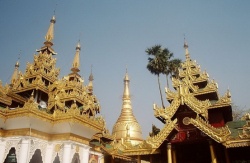Southern Buddhism
Southern Buddhism
南方仏教・南伝仏教 ( Jpn Nampo-bukkyoor Nanden-bukkyo)
Buddhism that spread from India to Sri Lanka and Southeast Asian countries such as Myanmar, Thailand, Laos, and Cambodia. The term Southern Buddhism contrasts with Northern Buddhism, which spread to Central Asia, Tibet, China, Korea, and Japan. Southern Buddhism is also called Theravada Buddhism or Southern Theravada Buddhism. Southern Buddhism is placed in the category of Hinayana.Hinayana, or Lesser Vehicle, was originally a pejorative term employed by Mahayana Buddhists. In the areas where Theravada Buddhism was disseminated, Mahayana Buddhism also spread, but it was ultimately superseded by Theravada.
Theravada Buddhism is based upon the Pali canon called Tipitaka (Skt Tripitaka ), which consists of sutras, texts on rules of monastic discipline, and doctrinal commentaries. Theravada Buddhists revere Shakyamuni Buddha, the founder of Buddhism, as the sole perfect master and teacher.Based on the Pali canon, monks strive to adhere to the doctrines and practices taught by Shakyamuni Buddha, endeavor to observe the precepts, and involve themselves in charitable activities. Laypersons accumulate benefits through offerings to monasteries and monks. Many people hold faith in Theravada Buddhism while retaining indigenous beliefs that are regarded as compatible with Buddhism. The introduction of Buddhism into Sri Lanka dates back to the third century B.C.E. During the reign of the Indian king Ashoka, the king's son Mahendra brought Theravada Buddhism to Sri Lanka. The Sri Lankan king, Devanampiya Tissa, built for Mahendra the Mahavihara monastery in the capital of Anuradhapura. That monastery is the center of Theravada Buddhism among Southeast Asian countries, and Theravada Buddhists in these countries maintain close contact with fellow Buddhists in Sri Lanka.
In the first century B.C.E., another monastery called Abhayagiri was built, which eventually led to the split of the Buddhist Order in Sri Lanka into the Mahavihara school and the Abhayagiri school. In the Abhaya-giri monastery, Mahayana Buddhism was also studied. In the fifth century, Buddhaghosa went from India to Sri Lanka and systematized the Theravada doctrines in accordance with the Mahavihara lineage. The first people in Myanmar to receive Theravada Buddhism were the Mons in the cities of Thaton and Pegu. Theravada Buddhism took firm root within that Burmese tribe in the eleventh century during the reign of Anawrahta of the Pagan kingdom. Anawrahta declared himself the champion of Theravada Buddhism. He unified the area that is today Myanmar and founded the first Burmese Empire.
In Thailand, Theravada Buddhism had been introduced by the thirteenth century, when Sukhothai, the first kingdom of the Thai, emerged. It took root within the Sukhotha kingdom and continued to prosper in the Ayutthaya kingdom, which emerged in the mid-fourteenth century. To date, Theravada Buddhism has continued to be a major pillar of Thai society. For a short period sometime during their lifetime, Buddhist laymen join a monastery to receive instruction. Currently, in Sri Lanka, Myanmar, and Thailand, the greater part of the population are Theravada Buddhists. It is a predominant religion in Cambodia and Laos, and there are followers of Theravada in Bangladesh, Indonesia, Malaysia, and Singapore.
